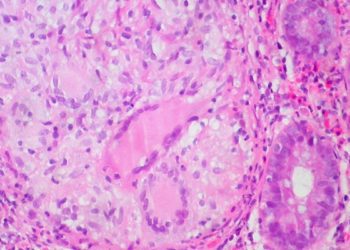2 Minute Medicine Rewind October 15, 2018
Timing of Renal-Replacement Therapy in Patients with Acute Kidney Injury and Sepsis
Acute kidney injury is a common complication of septic shock. Renal replacement therapy (RRT) is always initiated in the presence of life-threatening sequelae of acute kidney injury, such as hyperkalemia or metabolic acidosis, however, the ideal timing of RRT initiation in the absence of such complications remains unclear. In this randomized controlled trial, 488 patients with early-phase septic shock and acute kidney failure were assigned to early RRT (within 12 hours after documentation of acute kidney failure) or delayed RRT (after 48 hours) to assess the impact on death from any cause at 90 days after randomization. The trial was stopped early due to futility, at which point the calculated conditional power was 51.44%. In the early RRT group, 97% of patients received RRT, and in the delayed RRT group, 62% received RRT. Of the remaining patients in the delayed RRT group, 29% had spontaneous recovery of renal function, and 8% died before RRT initiation. Researchers found that there was no difference in mortality between the two groups at 90 days (58% died in the early RRT group vs. 54% in the delayed-RRT group, p=0.38). The delayed RRT group underwent significantly fewer days of RRT (median 16 days, IQR 2 to 28 days) than the early RRT group (median 12 days, IQR 1 to 125 days, p=0.006). There were no significant differences between the groups in any of the secondary outcomes. Overall, results from this study indicate that delayed initiation of renal replacement therapy may be as effective as early initiation in patients with septic shock and acute renal failure. Furthermore, it may spare some patients from exposure to RRT in whom spontaneous recovery of renal function is possible.
Although more than 3 million women give birth in the United States each year, there is no consensus regarding the optimal timing of maternal pushing during the second stage of labor (defined as the time from complete cervical dilation to delivery of the fetus). The two most common approaches are to either initiate pushing immediately upon entry into the second stage, or to delay pushing to allow time for spontaneous descent of the fetus. In this randomized controlled trial, 2,414 nulliparous women at or beyond 37 weeks gestation in spontaneous or induced labor with neuraxial analgesia were assigned to either immediate pushing or delayed pushing (instructed to wait 60 minutes after randomization) once they had reached complete cervical dilation. The primary outcome was the rate of spontaneous vaginal delivery without the use of forceps, vacuum, or cesarean delivery. The trial was stopped early due to futility and concern for increased morbidity in the delayed pushing group. Researchers found that there was no difference in the rate of spontaneous vaginal delivery between the two groups (85.9% in the immediate pushing group vs. 86.5% in the delayed pushing group, RR 0.99, 95% CI 0.96 to 1.03, p=0.67). The immediate pushing group experienced a significantly shorter mean duration of the second stage of labor as compared with the delayed group (102.4 vs. 134.2 minutes, mean difference -31.8 minutes, 95% CI -36.7 to -26.9 minutes, p<0.001). Furthermore, the immediate pushing group had significantly lower rates of chorioamnionitis (6.7% vs. 9.1%, RR 0.70, 95% CI 0.66 to 0.90, p=0.005) and postpartum hemorrhage (2.3% vs. 4.0%, RR 0.60, 95% CI 0.3 to 0.9, p=0.03) than the delayed pushing group. Therefore, this trial supports the practice of immediate pushing upon entry into the second stage of labor in nulliparous women at full term.
Effect of Genetic Diagnosis on Patients with Previously Undiagnosed Disease
Thousands of patients suffering from chronic diseases remain undiagnosed despite extensive medical evaluation. In 2014, the Undiagnosed Diseases Network (UDN), a conglomeration of seven clinical sites comprising several sequencing cores, a model organism screening center, and a central biorepository, was established to address this problem. This report summarizes the results from the first consecutive 1519 patients referred to the UDN. Of these, 601 patients were ultimately accepted for evaluation by the UDN to determine the rate of diagnosis and the effect of diagnosis on medical care. The primary symptoms of referred patients were most commonly neurologic (40%) or musculoskeletal (10%). Of those referred, more pediatric patients were accepted than adult patients (57% vs. 28%, p<0.001). Of the accepted patients, 32% had previously undergone exome sequencing. Researchers found that, of the 382 patients who underwent a complete evaluation, 35% of patients received a diagnosis. Of the diagnoses, 11% were made based on clinical review alone and 74% were made on the basis of exome or genome sequencing. Twenty-three percent of diagnoses were new syndromes associated with a known or new gene, yielding a total of 31 new syndromes. Finally, 21% of diagnoses led to a recommendation regarding a change in therapy. Generalizability of the UDN approach is still limited, as most of the enrolled patients were white, had neurologic symptoms, and resided near major clinical sites. In summary, the UDN represents a promising effort to aid patients who have devastating undiagnosed conditions. Research into how this tool can be applied to the broader health care system is ongoing.
Some patients with septic shock have elevated levels of endotoxin, a potent activator of the host inflammatory response. High endotoxin activity is associated with multiple organ failure and higher rates of mortality. Several pharmacological therapies to neutralize endotoxin have been developed, including high-affinity polymyxin B hemoperfusion. Previous clinical trials targeting patients have produced negative results, but these studies did not exclude patients without high levels of endotoxin activity. In this randomized controlled trial, 450 patients with septic shock and an elevated endotoxin-activity assay level were assigned to either polymyxin B hemoperfusion treatments plus standard therapy or sham hemoperfusion plus standard therapy to assess whether polymyxin B hemoperfusion reduces mortality at 28 days compared with standard therapy. After the second interim analysis, an additional exclusion criterion was introduced for patients with a Multiple Organ Dysfunction Score (MODS) of 9 or less (MODS population) to restrict subsequent enrollment to patients with a greater mortality risk. Researchers found that there was no difference in mortality at 28 days between the two original study groups (37.7% in the polymyxin B group vs. 34.5% in the sham group, RR 1.09, 95% CI 0.85 to 1.39, p=0.49) or in the MODS population (44.5% vs. 43.9% respectively, RR 1.01, 95% CI 0.78 to 1.31, p=0.92). Overall, the results from this trial do not support the use of polymyxin B hemoperfusion to reduce mortality in critically ill patients with septic shock.
Classification and Personalized Prognosis in Myeloproliferative Neoplasms
Myeloproliferative neoplasms such as polycythemia vera, essential thrombocythemia, and myelofibrosis are chronic clonal hematopoietic disorders characterized by distinct clinical and morphologic features. There is a growing role for genomic information in the risk stratification and personalization of treatment and prognosis in patients with these conditions. In this genomic study, coding exons from 69 myeloid cancer genes in 2,035 patients were sequenced to develop a genomic classification system and prognostic model to predict outcomes in patients with myeloproliferative neoplasms. Researchers identified a total of 33 genes containing driver mutations. Of these, mutations in JAK2, MPL, and CALR accounted for 1831 driver mutations and were the sole abnormality in 45% of patients. The number of driver mutations per patient advanced with age and was higher in those with myelofibrosis than in those with polycythemia vera or essential thrombocythemia. Eight genomic subgroups with distinct clinical phenotypes were identified. Using these findings, researchers generated prognostic models capable of creating personalized clinical outcome predictions in patients with chronic-phase myeloproliferative neoplasms and myelofibrosis. Of note, certain genomic features were highly predictive of progression from chronic-phase disease to myelofibrosis and to acute leukemia in patients with myeloproliferative neoplasms. Overall, this study supports a role for myeloid cancer gene sequencing to better inform clinical decision-making surrounding treatment and prognosis for patients with myeloproliferative neoplasms.
Image: PD
©2018 2 Minute Medicine, Inc. All rights reserved. No works may be reproduced without expressed written consent from 2 Minute Medicine, Inc. Inquire about licensing here. No article should be construed as medical advice and is not intended as such by the authors or by 2 Minute Medicine, Inc.







